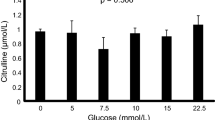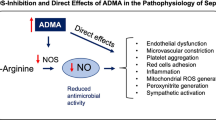Abstract
Objective
Tight glycaemic control by intensive insulin therapy (IIT) reduces morbidity and mortality in critically ill patients. As potential mechanisms contributing to the clinical benefits we hypothesized that glycaemic control affects regional nitric oxide (NO) bioavailability by changing NO synthases (NOS) activity, NOS transcription, NOS substrate availability or the endogenous NOS inhibitor asymmetric dimethylarginine (ADMA) levels.
Design
Prospective, randomized experimental study.
Setting
University medical laboratory.
Interventions
In a rabbit model of prolonged critical illness we assessed the relative impact of maintaining normal insulin/normoglycaemia (n = 8), high insulin/normoglycaemia (n = 8), normal insulin/hyperglycaemia (n = 9) and high insulin/hyperglycaemia (n = 8) plasma levels over 7 days on activity and gene expression of endothelial and inducible NOS isoforms in muscle, liver and aorta biopsies, and on plasma levels of NO, arginine and ADMA.
Measurements and results
Compared with normoglycaemic groups, both hyperglycaemic groups revealed 53% higher day-3 NO plasma levels (p < 0.05), 40% lower NOS activity in muscle (p < 0.01) and 35% lower endothelium-mediated relaxation of aortic rings (p < 0.01), 515% higher gene expression of iNOS in muscle (p < 0.01) and 99% higher eNOS gene expression in aorta (p < 0.01). Only the hyperglycaemic/hyperinsulinaemic group showed lower arginine plasma levels (53% lower, p < 0.0001). Compared with healthy controls, normoglycaemic animals revealed 33% lower ADMA levels (p < 0.05).
Conclusions
In this animal model of prolonged critical illness, maintaining normoglycaemia, and not glycaemia-independent actions of insulin, prevented excessive systemic NO release on day 3 and appeared to preserve local endothelial function. Factors contributing to this finding may comprise direct endothelial cell damage, direct effects on the enzyme activity, decreased substrate availability or less NO-induced inhibition.




Similar content being viewed by others
References
Nasraway SA Jr (2006) Hyperglycemia during critical illness. J Parenter Enteral Nutr 30:254–258
Van den Berghe G, Wouters P, Weekers F, Verwaest C, Bruyninckx F, Schetz M, Vlasselaers D, Ferdinande P, Lauwers P, Bouillon R (2001) Intensive insulin therapy in critically ill patients. N Engl J Med 345:1359–1367
Pittas AG, Siegel RD, Lau J (2006) Insulin therapy and in-hospital mortality in critically ill patients: systematic review and meta-analysis of randomized controlled trials. J Parenter Enteral Nutr 30:164–172
Van den Berghe G, Wilmer A, Hermans G, Meersseman W, Wouters PJ, Milants I, Van Wijngaerden E, Bobbaers H, Bouillon R (2006) Intensive insulin therapy in the medical ICU. N Engl J Med 354:449–461
Van den Berghe G (2004) How does blood glucose control with insulin save lives in intensive care? J Clin Invest 114:1187–1195
Langouche L, Vanhorebeek I, Vlasselaers D, Vander Perre S, Wouters PJ, Skogstrand K, Hansen TK, Van den Berghe G (2005) Intensive insulin therapy protects the endothelium of critically ill patients. J Clin Invest 115:2277–2286
Ellger B, Debaveye Y, Vanhorebeek I, Langouche L, Giulietti A, Van Etten E, Herijgers P, Mathieu C, Van den Berghe G (2006) Survival benefits of intensive insulin therapy in critical illness: impact of maintaining normoglycemia versus glycemia-independent actions of insulin. Diabetes 55:1096–1105
Siroen MP, van Leeuwen PA, Nijveldt RJ, Teerlink T, Wouters PJ, Van den Berghe G (2005) Modulation of asymmetric dimethylarginine in critically ill patients receiving intensive insulin treatment: A possible explanation of reduced morbidity and mortality? Crit Care Med 33:504–510
Li H, Wallerath T, Forstermann U (2002) Physiological mechanisms regulating the expression of endothelial-type NO synthase. Nitric Oxide 7:132–147
Hallemeesch MM, Janssen BJ, de Jonge WJ, Soeters PB, Lamers WH, Deutz NE (2003) NO production by cNOS and iNOS reflects blood pressure changes in LPS-challenged mice. Am J Physiol Endocrinol Metab 285:E871–E875
Kuboki K, Jiang ZY, Takahara N, Ha SW, Igarashi M, Yamauchi T, Feener EP, Herbert TP, Rhodes CJ, King GL (2000) Regulation of endothelial constitutive nitric oxide synthase gene expression in endothelial cells and in vivo: a specific vascular action of insulin. Circulation 101:676–681
Aktan F (2004) iNOS-mediated nitric oxide production and its regulation. Life Sci 75:639–653
Rawlingson A (2003) Nitric oxide, inflammation and acute burn injury. Burns 29:631–640
Lopez A, Lorente JA, Steingrub J, Bakker J, McLuckie A, Willatts S, Brockway M, Anzueto A, Holzapfel L, Breen D, Silverman MS, Takala J, Donaldson J, Arneson C, Grove G, Grossman S, Grover R (2004) Multiple-center, randomized, placebo-controlled, double-blind study of the nitric oxide synthase inhibitor 546C88: effect on survival in patients with septic shock. Crit Care Med 32:21–30
Siroen MP, Teerlink T, Nijveldt RJ, Prins HA, Richir MC, van Leeuwen PA (2006) The clinical significance of asymmetric dimethylarginine. Annu Rev Nutr 26:203–228
Tsikas D, Boger RH, Sandmann J, Bode-Boger SM, Frolich JC (2000) Endogenous nitric oxide synthase inhibitors are responsible for the L-arginine paradox. FEBS Lett 478:1–3
Ellger B, Richir MC, Langouche L, van Leeuwen PA, Van den Berghe G (2007) Normoglycemia and not glycemia-independent actions of insulin maintain physiologic NOS-activity by preserving physiological regulation of ADMA-levels. EJA 24 edn, p S40
Ellger B, Richir MC, Langouche L, Debaveye Y, Vanhorebeek I, van Leeuwen PA, Van den Berghe G (2007) Endothelial dysfunction in critical illness: Glycemic control or glycemia independent actions of insulin? EJA 32[S1] edn, p S273
Nyomba BL, Bouillon R, De Moor P (1984) Influence of vitamin D status on insulin secretion and glucose tolerance in the rabbit. Endocrinology 115:191–197
Brealey D, Brand M, Hargreaves I, Heales S, Land J, Smolenski R, Davies NA, Cooper CE, Singer M (2002) Association between mitochondrial dysfunction and severity and outcome of septic shock. Lancet 360:219–223
Laleman W, Omasta A, Van de Casteele M, Zeegers M, Vander Elst I, Van Landeghem L, Severi T, van Pelt J, Roskams T, Fevery J, Nevens F (2005) A role for asymmetric dimethylarginine in the pathophysiology of portal hypertension in rats with biliary cirrhosis. Hepatology 42:1382–1390
Hattori Y, Gross SS (1993) GTP cyclohydrolase I mRNA is induced by LPS in vascular smooth muscle: characterization, sequence and relationship to nitric oxide synthase. Biochem Biophys Res Commun 195:435–441
Teerlink T, Nijveldt RJ, de Jong S, van Leeuwen PA (2002) Determination of arginine, asymmetric dimethylarginine, and symmetric dimethylarginine in human plasma and other biological samples by high-performance liquid chromatography. Anal Biochem 303:131–137
Taubert D, Rosenkranz A, Berkels R, Roesen R, Schomig E (2004) Acute effects of glucose and insulin on vascular endothelium. Diabetologia 47:2059–2071
Kahn AM, Allen JC, Seidel CL, Lichtenberg DS, Song T, Zhang S (2000) Insulin increases NO-stimulated guanylate cyclase activity in cultured VSMC while raising redox potential. Am J Physiol Endocrinol Metab 278:E627–E633
Kroder G, Bossenmaier B, Kellerer M, Capp E, Stoyanov B, Muhlhofer A, Berti L, Horikoshi H, Ullrich A, Haring H (1996) Tumor necrosis factor-alpha- and hyperglycemia-induced insulin resistance. Evidence for different mechanisms and different effects on insulin signaling. J Clin Invest 97:1471–1477
Federici M, Menghini R, Mauriello A, Hribal ML, Ferrelli F, Lauro D, Sbraccia P, Spagnoli LG, Sesti G, Lauro R (2002) Insulin-dependent activation of endothelial nitric oxide synthase is impaired by O-linked glycosylation modification of signaling proteins in human coronary endothelial cells. Circulation 106:466–472
Liu S, Adcock IM, Old RW, Barnes PJ, Evans TW (1993) Lipopolysaccharide treatment in vivo induces widespread tissue expression of inducible nitric oxide synthase mRNA. Biochem Biophys Res Commun 196:1208–1213
Ste-Marie L, Hazell AS, Bemeur C, Butterworth R, Montgomery J (2001) Immunohistochemical detection of inducible nitric oxide synthase, nitrotyrosine and manganese superoxide dismutase following hyperglycemic focal cerebral ischemia. Brain Res 918:10–19
Stockklauser-Farber K, Ballhausen T, Laufer A, Rosen P (2000) Influence of diabetes on cardiac nitric oxide synthase expression and activity. Biochim Biophys Acta 1535:10–20
Jimenez-Feltstrom J, Lundquist I, Salehi A (2005) Glucose stimulates the expression and activities of nitric oxide synthases in incubated rat islets: an effect counteracted by GLP-1 through the cyclic AMP/PKA pathway. Cell Tissue Res 319:221–230
Hansen TK, Thiel S, Wouters PJ, Christiansen JS, Van den Berghe G (2003) Intensive insulin therapy exerts antiinflammatory effects in critically ill patients and counteracts the adverse effect of low mannose-binding lectin levels. J Clin Endocrinol Metab 88:1082–1088
Griscavage JM, Hobbs AJ, Ignarro LJ (1995) Negative modulation of nitric oxide synthase by nitric oxide and nitroso compounds. Adv Pharmacol 34:215–234
Lee J, Ryu H, Ferrante RJ, Morris SM Jr, Ratan RR (2003) Translational control of inducible nitric oxide synthase expression by arginine can explain the arginine paradox. Proc Natl Acad Sci USA 100:4843–4848
Stuhlinger MC, Abbasi F, Chu JW, Lamendola C, McLaughlin TL, Cooke JP, Reaven GM, Tsao PS (2002) Relationship between insulin resistance and an endogenous nitric oxide synthase inhibitor. J Am Med Assoc 287:1420–1426
Sorrenti V, Mazza F, Campisi A, Vanella L, Li VG, Di GC (2006) High glucose-mediated imbalance of nitric oxide synthase and dimethylarginine dimethylaminohydrolase expression in endothelial cells. Curr Neurovasc Res 3:49–54
Miyazaki H, Matsuoka H, Cooke JP, Usui M, Ueda S, Okuda S, Imaizumi T (1999) Endogenous nitric oxide synthase inhibitor: a novel marker of atherosclerosis. Circulation 99:1141–1146
Acknowledgements
We thank S. Fieuws, Biostatistical Center, School of Public Health, Katholieke Universiteit Leuven, Belgium, for independently reviewing the statistical analysis, and E. Van Herck, S. Vander Perre, S. Derde, E.-J. Ververs, I. Jans, K. Reyniers, M. Mathys, R. Bouillon and P. Wouters for their support. The work was supported by Innovative Medizinische Forschung (EL 610304), B. Braun Stiftung, Germany (B.E.), postdoctoral fellowship of the Fund for Scientific Research (FWO), Belgium (L.L., I.V.), doctoral fellowship FWO, Belgium (Y.D.), FWO, an unrestricted Novo Nordisk grant and the Research Council of the University of Leuven, Belgium. We thank B. Braun, Melsungen, Germany, Tyco Healthcare, Mechelen, Belgium, Fresenius-Kabi, Wilrijk, Belgium, and Baxter, Lessines, Belgium, for technical support.
Author information
Authors and Affiliations
Corresponding author
Additional information
An erratum to this article can be found at http://dx.doi.org/10.1007/s00134-008-1185-6
Electronic supplementary material
Rights and permissions
About this article
Cite this article
Ellger, B., Langouche, L., Richir, M. et al. Modulation of regional nitric oxide metabolism: Blood glucose control or insulin?. Intensive Care Med 34, 1525–1533 (2008). https://doi.org/10.1007/s00134-008-1118-4
Received:
Accepted:
Published:
Issue Date:
DOI: https://doi.org/10.1007/s00134-008-1118-4




